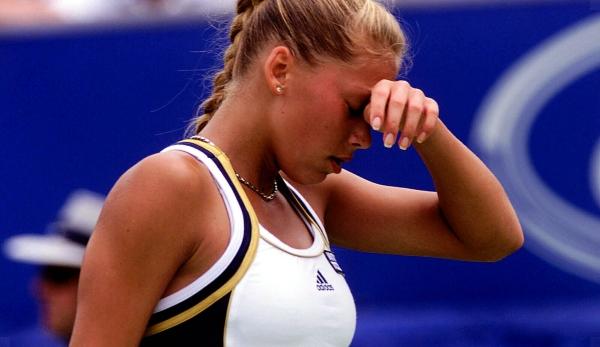The Russian served herself in the record books in Melbourne in 1999.
By Christian Albrecht Barschel
The serve is not only one of the most complex strokes in tennis, it is also considered the most important stroke in tennis. Because the serve is the only shot you can have full control over without being pressured by your opponent. Therefore, it’s especially bad if you lose control of this shot and double error by double error. Many hobby players and ambitious amateur players can sing a song about it if the serve spoils a whole match.
But even some pros and world-class players know the situation when the serve and its complex movement doesn’t work out like it did 1000 times – when you’ve caught the “yips”. What are the “Yips” anyway? The “yips” are sudden sudden muscle twitches that make it difficult to strike. This phenomenon is also very common in golf. One of the most prominent “Yips”victims in tennis was Anna Kournikova. Between October 1998 and his departure from the Australian Open in 1999, Kournikova made 182 double errors in only ten matches. In Melbourne, the Russian served herself in the record books.
In the second round against the Japanese Miho Saeki in 1999, she made an incredible 31 double errors. She still holds the record in this category today – both for men and women. Surprisingly, Kournikova won the match, just like in the first round with 23 double errors and in the third round with 14 double errors. After a total of 73 double mistakes, Kournikova finished the round of sixteen:”I’m really frustrated because everyone is watching. I feel good in practice. I serve it normally, there’s no sign of double faults. But when I get to the contest, something happens. I have to get over it and try to fight it like I did today,”Kournikova said after her “record match”.
“It’s more of a biomechanical problem than a head problem,”said the renowned psychologist Dr. Jim Loehr, who had worked with Pete Sampras and Jim Courier, among others, on Kournikova’s “Service Yips” at the time, says:”From time to time people get on the nerves. Normally it is the weakest strokes that fail under pressure. And that’s because the mechanics are so weak that they won’t give you any leeway if you’re tense and still want to play aggressive. The players who have shallow strokes and hardly any margin for error make many mistakes when they start to get nervous. One way to stop this is to give the ball more spin,”said Loehr about the service yips.
“Anna’s case adds an emotional element. She’s lost all her confidence. If she trains, it’s okay. She rarely has problems with double faults. And then she goes into the match and starts beating 15 to 25 double faults,”Loehr said about Kournikova and advised her:”My recommendation would be that she be videotaped to show her how the mechanics of the beat change when she’s in a stressful situation – compared to a relaxed situation.” Kournikova finally got over the “yips” and served until she was in a relaxed situation.
Beside Kournikova there were always prominent players who also had to fight with their serve. Elena Dementieva, for example, repeatedly made her life difficult due to her second serve, which was sometimes substandard, and served numerous double errors (Dementieva’s record is 29), which partly prevented her from achieving even greater career success. Even among the current generation there are some top players, where a two-digit number of double errors per match is the order of the day. Maria Sharapova, Victoria Azarenka, Petra Kvitova and Sabine Lisicki occasionally scatter double-fault orgies.
But the “Service Yips” did not even stop at the gentlemen’s door. Former world number three Guillermo Coria suffered at times from a glaring impact weakness, which ultimately heralded the end of his career. The Argentinean caught the “Yips” shortly before the U. S. Open 2005 and couldn’t get rid of them. 20 double errors per game were not uncommon, he also made four double errors in a row. Coria is the front runner for double faults in two sets (23) and three sets (also 23). Nevertheless, the Argentinean often managed to win, which shows his outstanding talent. In the 2006 round of sixteen in Monte Carlo against Nicolas Kiefer, he made 23 double mistakes and still won.
Generally speaking, the Australian Open seems to attract many double errors. Petra Kvitova served herself in the second round in 2013 with 18 double errors from the tournament. In the same year Gael Monfils made 23 double errors and still won. However, a record is set for eternity. Maria de Amorin from Brazil beat an incredible 17 double errors in 1957 in the first round of Wimbledon, and that in a row!














You must be logged in to post a comment Login